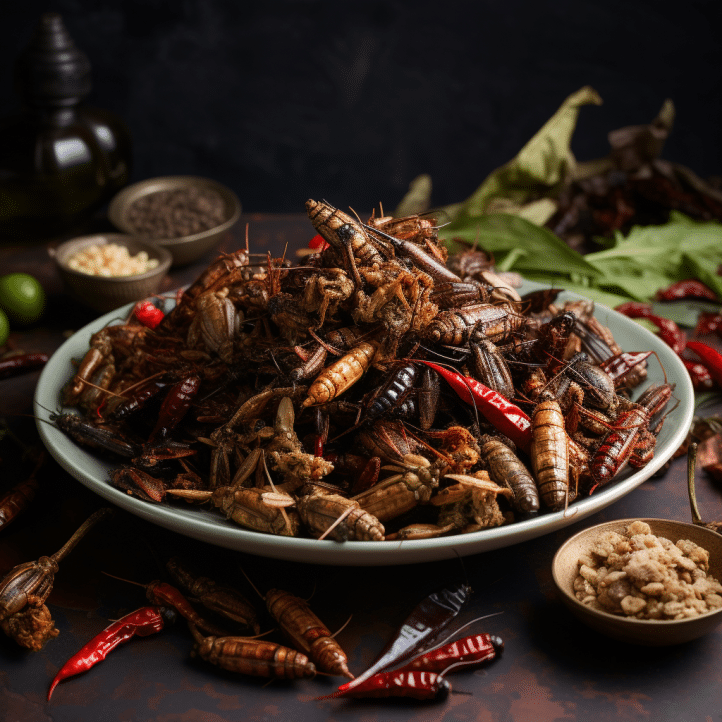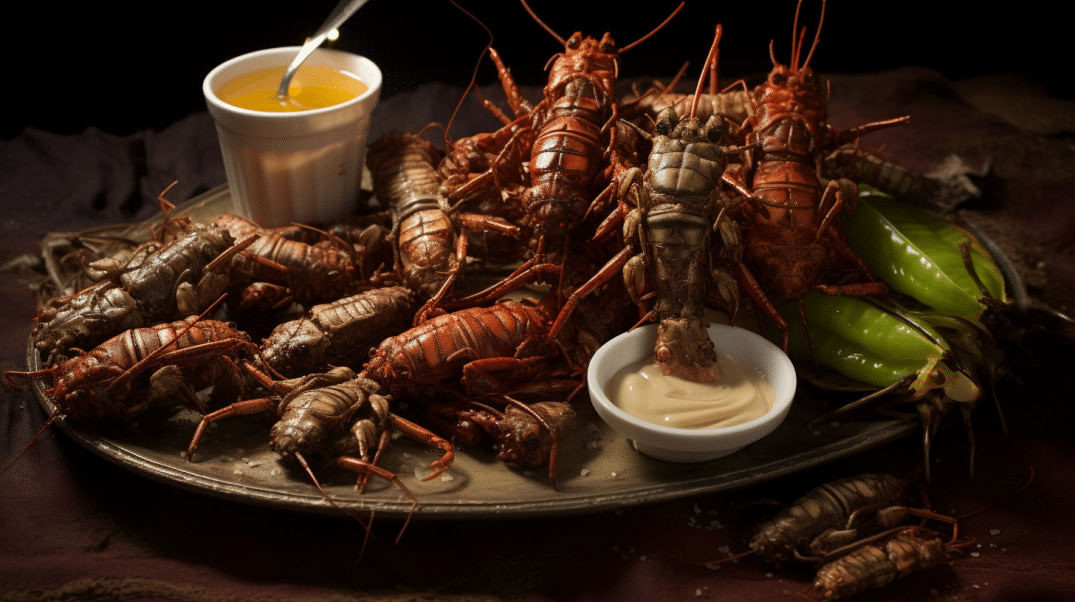Edible insects offer immense potential as a sustainable and nutritious protein source that could help feed the growing global population.
Key facts:
- Nearly 2 billion people worldwide already eat insects as part of their diet and culture.
- Insects require far less resources (land, water, feed) to produce the same amount of protein as livestock.
- Farm-raised insects have high protein content, essential amino acids, healthy fats, fiber, vitamins and minerals.
- Insects can be processed into flours, powders and extracts to make them more palatable for western cultures.
- Challenges remain around consumer acceptance, food safety, allergens and anti-nutrients.
Source: Adv Food Nutr Res. 2022
The Global Need for Sustainable Protein
By 2050, the world will need to increase food production by 50-70% to feed the projected population of 9 billion people.
Meeting this demand will put immense pressure on natural resources and the environment.
Traditional livestock like cattle, pigs and chickens require vast amounts of land, water and feed to produce protein.
This level of industrial farming emits large amounts of greenhouse gases and causes deforestation.
With arable land already scarce, we urgently need more eco-friendly and efficient ways to produce protein.
Edible insects offer a promising sustainable solution.
Also known as entomophagy, people have consumed insects for thousands of years as part of their native diets and culture.
Close to 2000 species have been recorded as edible, including crickets, grasshoppers, ants, bees, wasps, beetles, caterpillars and mealworms.
The Food and Agriculture Organization (FAO) of the United Nations now endorses entomophagy for its high nutritional value and lower environmental impact compared to traditional livestock.
Nutritional Benefits of Insects
Insects contain high quality protein, healthy fats, fiber, vitamins and minerals.
On a dry weight basis, protein content ranges from about 20-80%, depending on the species.
Crickets, grasshoppers and locusts have around 60% protein, which is comparable to fish, chicken and beef.
Insects are a complete protein source, providing all essential amino acids required by the human body.
The protein digestibility and bioavailability of certain insect species is over 90%, higher than common plant proteins like beans and grains.
Insects also provide polyunsaturated and monounsaturated fatty acids, such as omega-3s and omega-6s.
Mealworms contain healthy unsaturated fats comparable to fish oil.
Insects deliver fiber, mainly in the form of chitin from their exoskeleton.
Minerals like iron, zinc, magnesium and selenium are present in usable form.
Sustainability of Insect Farming: Crickets & Mealworms

Insect farming requires far fewer resources than livestock to produce the same edible protein yield.
Crickets need 12 times less feed than cattle to produce the same amount of protein.
The feed conversion efficiency of crickets is twice as high as chickens and pigs. Insects also grow and reproduce quickly compared to livestock.
The life cycle from egg to adult may only take a few weeks.
As a result, insects can be produced in greater numbers with less space and in less time.
For example, 100 m2 can yield 150-200 kg of cricket protein annually, compared to less than 100 kg of beef or 30 kg of pork from the same land size.
Greenhouse gas emissions are lower as well.
Crickets and mealworms produce 100 times less greenhouse gases per kilogram of protein than cattle.
Switching even just 25% of current meat protein to insect protein could significantly reduce emissions by around 23 million metric tons per year.
With their excellent feed conversion, rapid growth and low environmental impact, insects are one of the most efficient forms of animal protein production.
Traditional Uses of Edible Insects
People have traditionally eaten insects raw, cooked, toasted, dried or ground into powder or paste.
Historical records date back to Ancient Greece and Rome where cicadas, beetle larvae and locusts were considered delicacies.
Several references to locusts as food exist in the Old Testament.
Ancient Aztec markets in Mexico City sold a variety of insects like stink bugs, ants, grasshoppers and maguey worms.
Indigenous groups in North America consumed insects including caterpillars, crickets, cicadas and dragonflies.
Today, insects remain a dietary staple in many countries. Crickets, palm weevil larvae, and grasshoppers are popular in Thailand, Africa and Mexico.
The mopane caterpillar is a key source of protein across southern Africa. Wasps are eaten in Japan.
North American examples are the agave worm harvested from tequila plants and ant eggs or escamoles eaten in Mexico.
Globally, over 1900 species have been documented as part of traditional diets.
While consumption has declined in some developing regions, interest in insects as food continues to grow.
Modern Insect Rearing and Processing
Commercial insect farms have emerged, primarily in Europe, North America, Asia and Africa, to produce insects like crickets, mealworms and black soldier flies for human consumption.
These operations employ vertical farming systems optimized for rapid growth and hygienic automated collection of insects.
Strategies include precisely controlled environments and specialized diets to raise large insect biomass while ensuring food safety.
Several processing methods make insects more acceptable and digestible for human foods and supplements:
- Whole insects may be cooked by boiling, frying, baking or toasting to improve palatability and shelf-life. Cooking also reduces microbes and anti-nutrients.
- Drying using hot air, freeze drying or spray drying preserves insects and creates shelf-stable powders. Milling further grinds them into flours.
- Extraction techniques like enzymatic digestion, fermentation and high-pressure processing isolate beneficial proteins, oils and bioactive compounds.
- Canning or retorting provides long term stability at room temperature. Grinding the canned product produces pastes.
- Texturization aligns proteins to mimic meat fibers. Extrusion combines insects with binders to create meat-like textures.
These methods allow insects to be incorporated into foods and supplements in ways that appeal to modern consumers.
Powders containing dried, ground insects can fortify flour, breads, snacks and protein bars.
Extracted proteins and oils enrich drinks, baked goods, pasta and processed meats.
Canned pastes and textured proteins substitute for meat in recipes.
Insects in Food Product Development
The versatility of insect ingredients enables numerous product innovations.
As consumer demand grows, food scientists have found promising applications in many categories:
Bakery: Cookies, breads, bagels, tortillas, muffins, pasta and crackers fortified with 5-20% dried insect powder, like cricket flour. Improves protein content and amino acid balance.
Snacks: Protein, granola and energy bars boosted with insect powder for added nutrition. Dried whole insects may be coated in chocolate or spice blends.
Meat alternatives: Burgers, sausages, nuggets and jerky analogues created with textured insect protein and flavorings. Resembles meat in taste and texture.
Beverages: Powders and extracted proteins such as cricket or mealworm hydrolysate used in smoothies, sport drinks and meal replacement shakes.
Confectionery: Chocolate-covered insects and candies with pulverized powder offer novelty and nutrition. Caramel-coated crickets are popular.
Condiments: Insect protein extracts utilized as emulsifiers and binders. Roasted insects add savory flavor to salts and seasoning blends.
Pasta: Mealworm and cricket flour add protein and fiber to pasta dough for nutrition-enhanced noodles.
Pet food: Dried insects provide natural protein and crunch to feeds. Supports the growing insect protein pet food segment.
Challenges: Insect Food Adoption
While interest and innovation accelerate in the West, barriers remain for full mainstream acceptance.
The foremost is the cultural stigma and neophobia towards eating insects, which are not viewed as normal food.
Unfamiliarity evokes disgust and hesitation.
Strategic public education by scientists and companies will help shift attitudes over time.
Preparing insects into subtle, unrecognizable forms like powders and extracts also improves acceptance.
Food safety concerns around pathogens, toxins and allergens need to be studied further as the industry scales up.
Proper processing, farming practices and sanitation controls can ensure microbiological safety.
Potential allergenic cross-reactivity between shellfish and insects warrants caution for those with seafood allergies.
Some antinutrients found in insects like phytates may limit mineral absorption.
Processing methods such as cooking and extraction can reduce certain anti-nutrients.
Consumer adoption faces psychological and educational hurdles.
But precedent shows tastes can evolve over time with increased exposure.
Sushi was once off-putting to Westerners but is now mainstream fare.
The same potential exists for insects as an eco-friendly protein of the future.
With pragmatic solutions to address legitimate concerns, edible insects can pave the way to feeding billions sustainably and deliciously.
References
- Study: Edible insects, a valuable protein source from ancient to modern times
- Author: Andrea M. Liceaga (2022)







